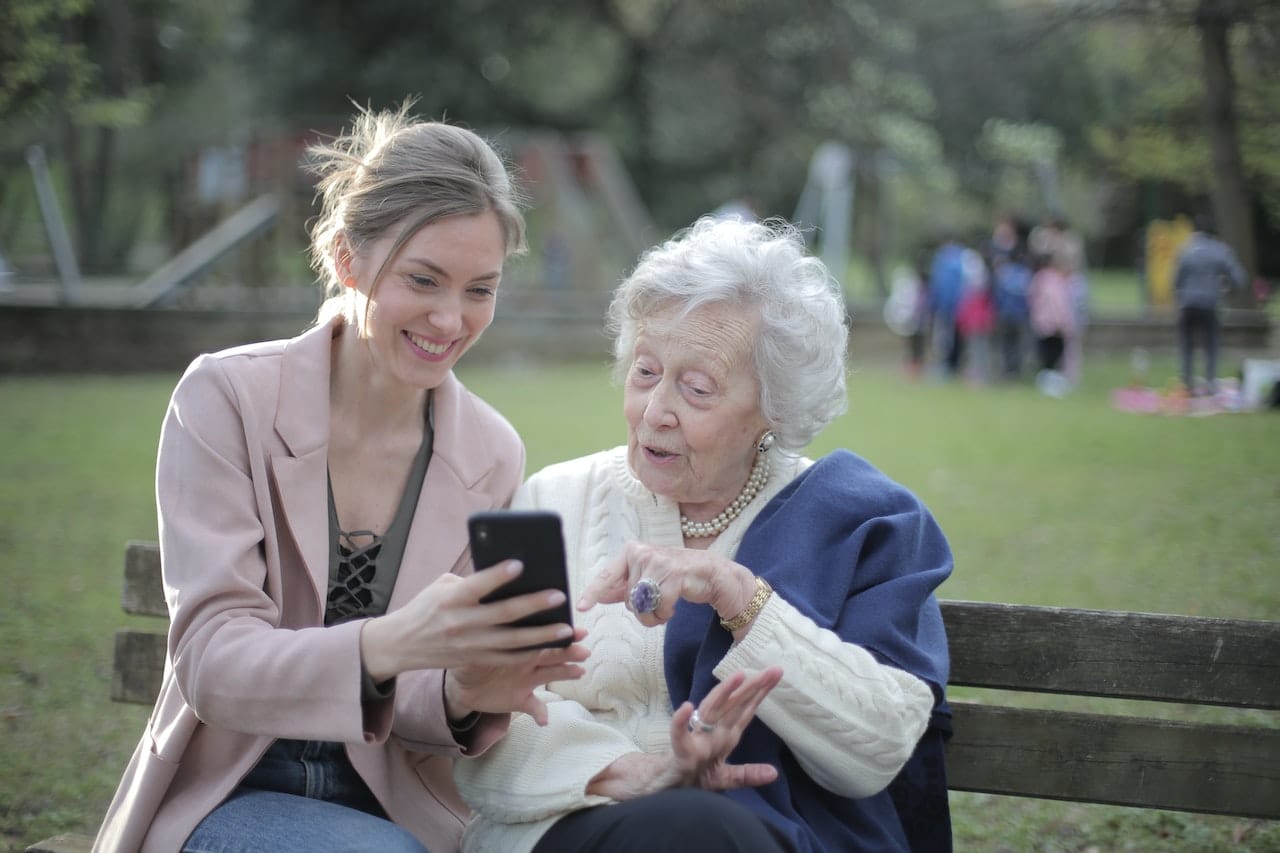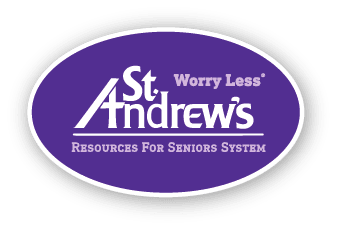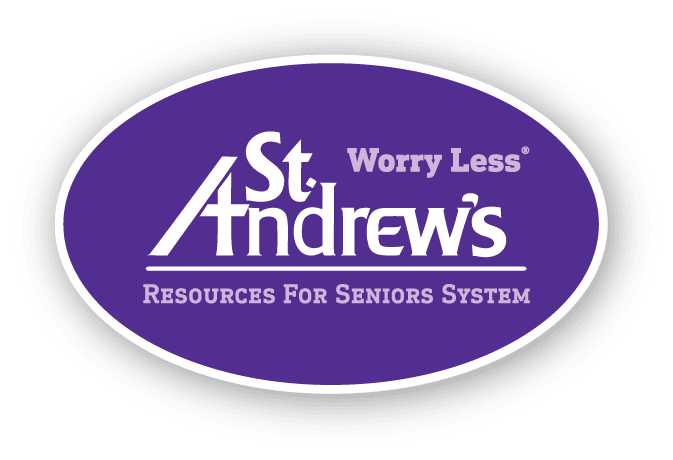Senior Living Terms Defined

As the nature of senior living communities has evolved in recent years, so has the language! St. Andrew’s has created this guide to share some common senior living terminology that you may use—and what terms we think should be avoided.
Contact us if you have any questions for yourself or a loved one going through the process of transitioning into senior living!
Glossary of Common Senior Living Terms
- Assisted Living: A type of senior housing that provides assistance with activities of daily living (ADLs), such as bathing, dressing, medication management, and meal preparation, while still allowing residents to maintain a certain level of independence.
- Independent Living: Housing designed for active seniors who are able to live on their own but want access to amenities, social activities, and a sense of community. These communities often offer services like housekeeping, transportation, and meal options.
- Memory Care: Specialized type of care for individuals with Alzheimer's disease, cognitive impairments, or other forms of dementia. Memory care communities provide a secure environment and tailored support to meet the unique care needs of residents with memory loss.
- Continuing Care Retirement Community (CCRC): Also known as a life plan community, a CCRC offers a range of housing options on a single campus, including independent living, assisted living, and nursing care. Residents can transition between these levels of care without having to leave the community, ensuring seamless support as their requirements evolve over time.
- Skilled Nursing Facility (SNF): A community that provides 24-hour medical care for individuals who require more intensive medical attention and assistance with daily activities due to illness, injury, or chronic conditions.
- Respite Care: Short-term care provided to seniors to give their regular caregivers a break. It can be provided in a senior living community or at home, and it offers temporary relief to caregivers while ensuring the well-being of the senior.
- Hospice Care: Care focused on providing comfort and support to individuals with terminal illnesses. Hospice care aims to improve the quality of life for individuals and their families during the final stages of life.
- Palliative Care: Specialized medical care focused on improving the quality of life for residents facing serious illnesses or conditions. The goal is to provide relief from symptoms, pain, and stress, regardless of the prognosis.
- Adult Day Care: A service that offers a safe and social environment where older adults can engage in recreational, social, and therapeutic activities while caregivers have time to work, run errands, or rest. Depending on the specific location, they can also provide health care services, personal care services, meals, and transportation. It can be an alternative to full-time in-home health care.
- Aging in Place: The ability for seniors to continue living in their own homes or chosen living environment as they age, with access to necessary support services and modifications to accommodate changing needs.
- Activities of Daily Living (ADLs): Basic self-care tasks that individuals usually perform daily, including bathing, dressing, grooming, eating, mobility, and toileting.
- Instrumental Activities of Daily Living (IADLs): More complex tasks necessary for independent living, such as managing finances, meal preparation, shopping, housekeeping, and medication management.
- Medicare: A federal health insurance program primarily for Americans aged 65 and older, but it can also cover certain younger individuals with disabilities. Medicare provides coverage for hospital care (Part A), medical services (Part B), and prescription drugs (Part D). Additionally, there's the option to choose a Medicare Advantage plan (Part C) that combines Parts A and B benefits and often includes extra services. Eligibility and benefits can vary from state to state.
- Medicaid: A joint federal and state program that provides health coverage to eligible low-income individuals and families. Medicaid offers a range of medical services, including hospital and doctor visits, preventive care, long-term care, and more. Eligibility and benefits can vary from state to state.
- Long-Term Care Insurance: Insurance coverage that helps pay for the cost of long-term care services, such as those provided in assisted living communities or home care settings.
- Care Plan: A personalized document outlining the individualized services, medical needs, preferences, and daily assistance required for a resident. It's regularly updated to reflect changes in the resident's condition and preferences.
- Continuum of Care: The range of housing and service options provided on a single campus to meet residents' changing needs as they age, including independent living, assisted living, memory care, and skilled nursing care.
- Living Will: A legal document that outlines a senior’s preferences and instructions so that healthcare decisions can be made that ensure the resident’s choices are respected and followed. It specifies the type of medical interventions they wish to receive or avoid if they become unable to communicate their wishes due to illness or incapacity.
- Power of Attorney: a legal document that allows someone (the "agent" or "attorney-in-fact") to make decisions on behalf of a senior living resident, should they become unable to make those decisions themselves due to illness or incapacity. This can include decisions related to healthcare, finances, property, and other matters.
- Rehabilitation services: Services that involve specialized therapies and exercises designed to help a senior recover and regain physical abilities after an illness, surgery, or injury. These services, which may include physical therapy, occupational therapy, and speech therapy, aim to improve mobility, strength, balance, and overall function, enabling seniors to perform daily activities more independently and with greater comfort.
- Physical Therapy: This type of therapy involves exercises and treatments to enhance independence, reduce discomfort, and overall improve physical mobility, strength, and balance.
- Occupational Therapy: This type of therapy involves personalized activities and exercises that help improve a senior’s ability to perform daily tasks more easily and independently. It focuses on maintaining or regaining skills for activities like dressing, bathing, cooking, and using tools.
- Speech Therapy: This type of therapy focuses on improving communication and addressing speech, language, and swallowing difficulties through various exercises, techniques, and strategies.
- Director of Nursing (DON): A senior-level healthcare professional responsible for overseeing and managing the nursing department. The DON ensures that high-quality care is provided to residents by coordinating nursing staff, implementing care plans, maintaining regulatory compliance, and facilitating communication between medical teams.
- Registered Nurse (RN): A licensed healthcare professional with specialized training and qualifications. RNs provide skilled medical care, administer medications, monitor health conditions, and coordinate care plans for residents.
- Licensed Practical Nurse (LPN): A healthcare service provider who provides essential medical support under the supervision of registered nurses and physicians. LPNs assist with tasks like administering medications, taking vital signs, dressing wounds, and monitoring residents' health.
- Certified Nursing Assistant (CNA): A professional who provides essential medical support under the supervision of registered nurses and LPNs. They have been trained on the skills needed to provide basic care and assistance with activities of daily living (ADLs), such as bathing, dressing, toileting, feeding, and transferring.
- Sandwich Generation: Individuals who are simultaneously caring for older relatives while also raising and providing support for their own children. These individuals find themselves "sandwiched" between the responsibilities of caring for both younger and older generations, often facing challenges related to time, finances, and emotional well-being.
REDEFINING Senior Living Language
The staff at St. Andrew’s believes that changing the language people use can improve their understanding of the industry as they research living options for themselves, a parent, or another family member. Here are some examples:
Avoid the term “nursing home” and say “senior living community”
When considering care options, many people may use or search for the term “nursing home,” but skilled nursing care is specific to those who require care that can only be administered by a licensed nurse or medical professional. In reality, most people searching that term are looking for a “senior living community,” which can offer services ranging from independent living to assisted living.
Avoid the term “facility” and say “community”
Using the word “facility” (assisted living facility, memory care facility, etc.) can bring to mind a clinical, sterile environment that focuses solely on medical care. However, senior communities are focused on fostering independence for residents by customizing the level of assistance provided. They are lively neighborhoods full of friendships, activities and events, and personalized comforts. The word “community” more accurately describes this family home-like setting
Avoid the term “patient” and say “resident”
Similar to the use of the word “facility,” many associate all types of senior care with being medical, where each person is seen only as a “patient.” While senior living communities have resources to manage health conditions, they are not hospitals. Senior living communities offer care but strive to improve the quality of life of their “residents” through their services and amenities.
Avoid the term “unit” and say “home or apartment”
Referring to a room or apartment in a senior living community as a “unit” can once again seem clinical and impersonal. Calling these spaces, apartments, residences, or homes, is a good reminder that, for residents of these communities, this is their home. These rooms are where they live, relax, and spend time with people they love.
Avoid the term “suffering from” and say “living with”
When we state that a person is “suffering from” a chronic illness, we let the disease define them, not who they are at their core. With a simple switch in language, “living with” a chronic illness focuses on the person, not the illness.
Avoid the term “cafeteria” and say “dining”
The word “cafeteria” may bring to mind a school lunchroom, complete with trays and bland buffet-style food. Today, senior living communities offer a variety of dining options, styles, and cuisines. For example, we pride our communities on our elevated dining experience that celebrates flavor and nutrition in every bite.
St. Andrew’s is Redefining the Senior Living Space
St. Andrew’s can provide whatever you need, whether it’s occasional help that allows a senior to remain independent at home, a comfortable retirement residence that feels like home, a caring assisted living or skilled nursing community, or even short-term Medicare Rehabilitation.
We help families find and access the support they need, and, most importantly, we help them Worry Less®.







